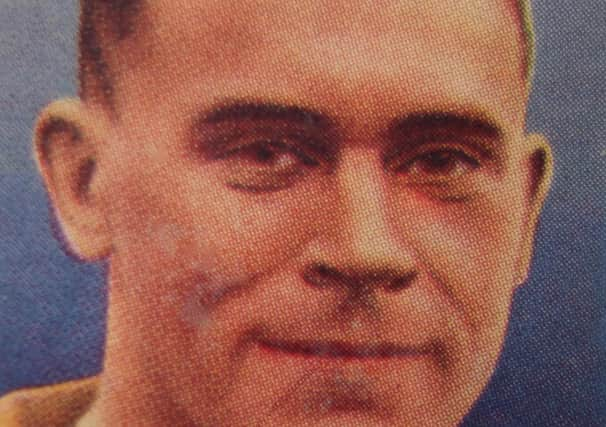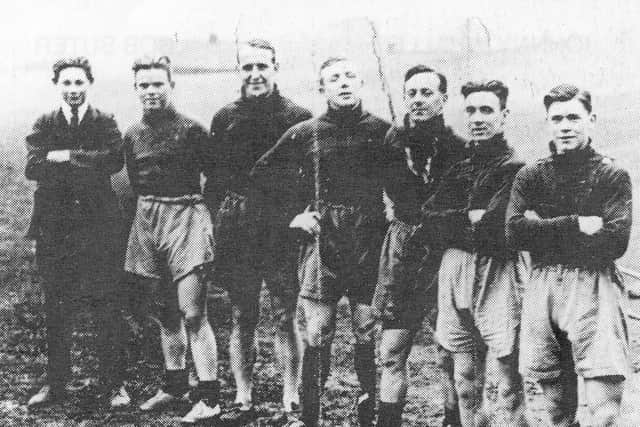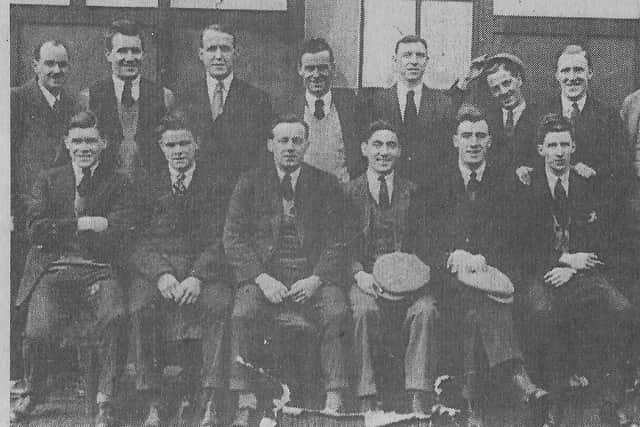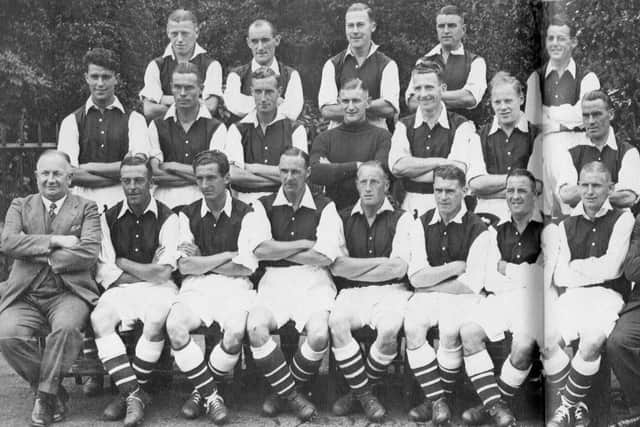The story of Ernie Coleman’s remarkable rise from Halifax Town to the top-flight


The rise of Jamie Vardy is one that is quite remarkable, especially considering he was a player still playing Unibond League football aged 23, yet went on to win the Premier League title and make 26 appearances for England.
His progress was monitored closely by FC Halifax Town supporters, who would justifiably claim that but for his time at The Shay, Vardy wouldn’t have had the breaks and made it as far as he did.
Advertisement
Hide AdAdvertisement
Hide AdWe still await the film and wonder just how his time here would be fitted into the script, for all the experts seemed to recall of his time in non-league football before being picked up by Leicester City boss Nigel Pearson was that spent with Stocksbridge Park Steels and Fleetwood Town.


Vardy’s exploits just about overshadowed the career of a Halifax Town player from a much earlier age, one who holds a unique place in the annals of the club for being the only player to leave The Shay and go on and win a League title.
England honours came close, but for Ernie Coleman, his rise to the top was as fleeting as it was remarkable, yet nevertheless, he trod a path that only Vardy would come to appreciate.
For like Vardy, as Town fans know only too well, it was at The Shay where he made his mark.
Advertisement
Hide AdAdvertisement
Hide AdErnest Coleman was born in Blidworth, Nottinghamshire, on 4 January 1908, and began kicking a ball around with any degree of seriousness when turning out for the Hucknall Church Boys’ Brigade side, and making three appearances for Nottinghamshire Schoolboys, before progressing to the senior Hucknall Church Boys.


With them, his 68 goals during the 1925-26 season not only went some way to helping the side win the title in the Red Triangle Football League, but also alerted bigger clubs to his talents.
Nottingham Forest took him on trial, without being impressed, and quick to step in was Halifax Town boss Joe McClelland, for no sooner had the season finished than he was moving to snap up the player who had just turned 18.
Coleman would spend the much of his first season at The Shay in the reserve side, making a somewhat inauspicious start to life in the Midland Combination by being part of the side humbled 5-1 by Stockport County Reserves on 28 August 1926.
Advertisement
Hide AdAdvertisement
Hide AdHe filled the centre forward role and took several games before getting into his stride, getting off the mark with a brace in a 6-0 defeat of Rochdale in his fourth match.


Chief goal-getter then was Jack Barber, ex-Manchester United but a player out of favour with the management, and there is little doubt that Coleman learnt much from him.
Goals stared to flow and the side climbed the table, the match with Barnsley at The Shay on 27 December a personal triumph for the young striker as he grabbed his first hat-trick in a 6-2 win.
It was certainly timely, for with McClelland and the selection committee scratching their heads over how to overcome the first teams’ slump in form which had seen them draw their last five matches, they decided on major changes for the New Year’s Day match with Rochdale, with Coleman, Barber and Sandy McGinn stepping up from the reserves.
Advertisement
Hide AdAdvertisement
Hide AdColeman scored the game’s only goal, one described as a ‘clever shot’ after just seven minutes, though it was another youngster who had recently stepped up from the reserves, goalkeeper Lewis Barber, who took the plaudits by making a string of top class saves to keep out the visitors.
An unchanged side then gained a creditable draw at Wigan Borough, but then the selection committee decided to promote Arthur Seabrook, and by the time the side found a winning formula, Coleman was back in the second string.
Still, his progress was monitored, and when he grabbed his second hat-trick, again against Barnsley in a reserve cup match, he received the call-up to the first team once more, taking the place at centre-forward of top scorer Ernie Dixon – he moved to inside-right – and duly grabbed a brace in a 3-0 win at Wigan Borough, both goals of class, the first a volley off a Sid Waites cross, the second after side-stepping a defender before driving home.
He figured in the next two games, but as the season drew to a close Coleman was back in the reserves, still having shown enough promise to be selected for the Yorkshire Combination representative side against champions Hull City on 27 April.
Advertisement
Hide AdAdvertisement
Hide AdThe only major new signings that summer came in the form of goalkeeper Fred Fox, offsetting the transfer of Lewis Barber to Manchester City, and half-back Hugh Hubbert, and Coleman found himself plying his trade once more in the second team, though he couldn’t complain too much.
Joe McClelland’s side challenged at the top of the Third Division (North) table and had the temerity to lead it mid-October.
But Coleman’s form was always a threat to any forward who might show a slump in form, indicated by his hat-trick in the 5-0 defeat of Chesterfield, then a nap-hand in the 10-1 demolition of Rotherham United on 5 November 1927, a game in which his compatriot Arthur Groves also scored four.
When the first team fell off the pace, Coleman was promoted once more, though not with any degree of success.
Advertisement
Hide AdAdvertisement
Hide AdHe came in for the injured Dixon for the home FA Cup tie with Hartlepools United and though he helped himself to what seemed his customary goal, rounding off a 3-0 win, his five-game run out at centre-forward in the League yielded nothing.
It was a different story back in the reserves, however, where there was no let up by the player and two weeks after helping himself to another five-goal haul in a 7-0 victory over Sutton Town,
Coleman, along with Groves, was called up for the first team, and there to stay. Adept at either leading the line or out on the right wing, Coleman added two more goals to his tally, and by the start of the 1928-29 campaign, he was first team material, albeit in a side going through what is generally termed a ‘transitional period’.
Coleman enhanced his growing reputation for the most part playing on the wing, netting in the season’s opener to earn Town a point in a 2-2 draw with Crewe Alexandra, his goal a real individual effort, breaking through and firing home from a tight angle despite being harassed by two defenders.
Advertisement
Hide AdAdvertisement
Hide AdHis next goal came in the derby in front of the biggest crowd seen at The Shay that term, 14,609 witnessing Coleman equalise within seconds of Tom Moon putting the visitors ahead.
He was joined once more in the first team by Groves, though his own contribution was relatively brief, for after just ten games that season, Groves was making a four-figure fee move to First division Blackburn Rovers.
Coleman must have wondered when the bright lights would start calling him, too, and almost in response, he hit a rich vein of form throughout late January and February which saw him score four goals in a five-match spell, shifting to inside-forward, so dangerous a forward did Coleman now appear.
Yet his goal in Town’s 3-1 defeat at Hartlepools on 23 February 1929, a 20-yarder which gave the Shaymen the lead in a match where he was described as the artist of the front rank, would be would be his last significant contribution to the cause.
Advertisement
Hide AdAdvertisement
Hide AdFour days later Coleman was sold to Grimsby Town for what was described as a ‘substantial fee’, the figure of £1,250 bandied about.
He left The Shay with 16 goals from 50 League and cup and appearances to his name.
At the time of his move to Blundell Park, Grimsby were eyeing promotion to the First Division, and manager Wilf Gillow evidently saw Coleman as a means to that end.
Though Middlesbrough were the runaway leaders of that division, the Mariners were one of a clutch of clubs tucked in behind.
Advertisement
Hide AdAdvertisement
Hide AdColeman wouldn’t be brought into the side until the end of March but his impact was immediate, scoring the only goal of the game on his debut in the victory over Oldham Athletic, finding the net in his next two games, and finishing with seven goals from just eight League appearances as Grimsby clinched runners-up spot and with it promotion to the top flight.
The Mariners’ initially adapted well to life back in the First Division they’d last been members of in 1903, yet Coleman’s performances on the right wing was largely undistinguished, and he was in and out of the side.
However, his first goal that term was one to savour, the fourth in a well-deserved 5-2 win against Manchester United at Old Trafford.
Coleman would score just one more goal that season as Grimsby’s form well away, and relegation was averted thanks to an end-of season run-in which saw them win five of their last six matches, albeit without Coleman.
Advertisement
Hide AdAdvertisement
Hide AdBut once he was unleashed at centre-forward in place of Joe Robson during 1930-31, Coleman would go on to write himself into Grimsby Town folklore.
He got off the mark at Manchester United – clearly Old Trafford was a happy hunting ground for him – and his haul of 35 goals, from 38 League games, included four goals in the 8-2 trouncing of Leicester City, and hat-tricks on no fewer than three other occasions.
And let it be said, for those who have followed the career of Jamie Vardy and acknowledged his record-breaking achievement of scoring in 11 consecutive Premier League matches, Ernie Coleman did something not dissimilar with the Mariners, scoring at one point, 19 goals in a spell of, you’ve guessed it, 11 consecutive matches, though one of those in that sequence was in an FA Cup defeat at Everton.
Grimsby finished thirteenth that season but found themselves locked in a relegation battle they would ultimately lose in 1931-32, their chances of survival rocked by the sale of Coleman on 4 March 1932 to Arsenal, who exchanged centre-back Billy Seddon as part of the deal.
Advertisement
Hide AdAdvertisement
Hide AdAt the time of Coleman’s departure, Grimsby were bottom of the table and could ill have afforded to be without their star forward, whose name had last appeared on the scoresheet when he blasted a hat-trick in a 5-1 defeat of Liverpool, goals which helped him remain the club’s leading goalscorer with 13 goals that season long after he’d gone.
But from a relegation dogfight, Coleman was now joining a club that was vying for the League title they’d won for the first time the previous year, Arsenal lying second, three points behind Everton, but with games in hand.
He figured in six games before the season’s close, scoring just one goal, the winner in the defeat of Huddersfield which kept the Gunners’ faint hopes of the title alive.
But the championship trophy went to Goodison Park, whilst misery for Arsenal was compounded when they also lost the FA Cup Final to Newcastle United, a match for which Coleman was cup-tied.
Advertisement
Hide AdAdvertisement
Hide AdFor Arsenal and their followers, however, there would be no such disappointment the following season.
The man who signed Coleman for Arsenal was their enigmatic, yet controversial manager Herbert Chapman, a figure who had been at the forefront of the Leeds City illegal payments scam during the First World War which led to the club’s suspension and players being auctioned off.
He had been working at a coke works in Selby when he returned to football, initially as secretary at Huddersfield Town in September 1920 before assuming control of the first team the following March.
There, he moulded the side into a championship winning one, and, indeed, had led them to two of their three consecutive titles before he got the call in June 1925 to take over as boss at Arsenal, where he looked set to repeat this feat.
Advertisement
Hide AdAdvertisement
Hide AdSix years later, they had on their books some of the finest players in the country at the time, such as full-backs Eddie Hapgood and George Male, winger Cliff Bastin, and prolific forwards Alex James and David Jack, and into this company stepped Ernie Coleman who, soon after making his mark, earned the nickname ‘Tim’, in honour of John Coleman, an Arsenal player of an earlier age, also nicknamed ‘Tim’.
Chapman saw in Coleman the leader of the line he needed, and the forward was soon among the goals, scoring sixteen before Christmas to help the Gunners to the top of the table, well clear of Aston Villa in second.
And initially there was no let-up in the New Year, though he was perhaps fortunate to have sat out through flu the shock FA Cup defeat at Third Division (North) Walsall in January.
Coleman was restored to the side for the visit of Manchester City the following week, and went on to help himself to hat-tricks in the 4-0 victory at Bolton Wanderers on 1 February, and the 8-0 demolition of Blackburn Rovers towards the end of that month to help Arsenal’s charge to the championship.
Advertisement
Hide AdAdvertisement
Hide AdHis form also brought him to the attention of the England selectors, though ultimately full international honours eluded him.
The closest Coleman got was when he led the line in an international trial match for England against The Rest at Portsmouth on 22 March 1933, though things didn’t go particularly well when The Rest, who included four of his Arsenal team mates, ran out 5-1 winners.
Yet, seemingly at the top of his game, Coleman’s time in the Arsenal first team was about to be limited, but who could have foreseen that?
When he failed to score in Arsenal’s next four matches, none of which were won, the Gunners’ lead at the top was cut to one point and Chapman rang the changes, with Coleman losing his place at centre-forward to Jack Lambert. The ship steered back on course, the title was duly captured, and Coleman claimed his League championship medal, having appeared in 27 matches, contributing a handsome 24 goals, second only to Bastin, who scored 33.
Advertisement
Hide AdAdvertisement
Hide AdHerbert Chapman, a master tactician, was, above most things, ruthless in his determination to win honours.
Thus, any lack of form would be acted upon, as Coleman found out. He wasn’t now a certain starter during the 1933-34 season and would feature in just 12 matches and score just the one goal, a cross shot in Arsenal’s 1-1 draw with Manchester City on 9 September 1933.
Yet he was in the side for the match with Sheffield Wednesday that strangely went ahead on 6 January 1934 despite the news that reached the club that Chapman had died earlier that morning. Joe Shaw oversaw the game, another 1-1 draw, but thereafter Coleman would appear in just two more first team games.
The signing of Ted Drake in March 1934 pushed Coleman further down the pecking order and he spent the rest of that season with the reserves in the London Combination, and whilst Arsenal went on to claim a second successive League title, Coleman hadn’t played in enough games to qualify for another medal.
Advertisement
Hide AdAdvertisement
Hide AdInstead, his future lay elsewhere, but he remained in the First Division with Middlesbrough, having joined them that close season, his transfer commanding a £4,000 fee.
Coleman would spend three seasons with the Ayresome Park club, helping to keep them in the top flight, and though never scaling the heights he had with Arsenal, he still had his moments, such as when he grabbed both goals in Boro’s 2-0 win over Liverpool on New Day’s Day 1935.
But he had something of a shock when he returned to Highbury for the League meeting on 19 April.
Arsenal showed little mercy and perhaps indicated why they were on their way to their third successive League championship by putting eight goals past Coleman’s side.
Advertisement
Hide AdAdvertisement
Hide AdNevertheless, Coleman linked up well with the famous George Camsell, netting 11 goals in his first season and being a regular in the side during his time there, making 85 League appearances and scoring 20 goals before finishing his League a career with Norwich City, whom he joined in February 1937.
There, he showed he wasn’t quite finished, even if he was now back in the Second Division, and was the Canaries’ top scorer with 15 goals in his second season.
Coleman went on to score 25 League goals from 63 appearances, bringing the curtain down on a remarkable career by helping his side to a 1-0 victory over Nottingham Forest, of all clubs, the one which had rejected him all those years earlier.
Whether Jamie Vardy ever turns out to be of managerial stock remains to be seen. It might be the case that by the time he retires from playing he may have no need to further a coaching career, but in the case of Coleman, he had much to offer.
Advertisement
Hide AdAdvertisement
Hide AdThough employed in Norwich at the start of the war as a general labourer – not football related – he later returned to Nottingham and took over as player-trainer with Linby Colliery, introducing to the club a red and white strip in honour of his time with Arsenal.
In his first season he netted 50 goals and continued playing until he was nearly 40.
A popular character, in July 1957 he succeeded Eddie Lowe as manager of Notts County, albeit in a caretaker capacity, then had two spells in the job full-time, discovering players of the calibre of Jeff Astle, who later played for West Brom and England.
He also had under his charge the brash Tony Hateley, and both he and Astle were part of the Notts County side which earned County a 2-1 victory when Coleman returned to The Shay, which had changed little since his day, for the first time for a League a match on 9 April 1962.
Advertisement
Hide AdAdvertisement
Hide AdIn 1962-63 he took County close to promotion from the Fourth Division, and after stepping down, returned in April 1965 to aid a financial crisis, eventually leaving the club in March 1966.
It is incredible to think that, Vardy alone, no other player has left Halifax Town and gone on to win a League Championship medal, or Premier League equivalent.
The closest was probably Bobby Davision, top scorer with Town in 1981-82, who, ten years later, made two substitute appearances for Leeds United when they were crowned the last winners of the Football League as we used to know it.
Alan Waddle was at Liverpool when they pipped Queen’s Park Rangers for the title in 1975-76, but never appeared in a League game for the Reds that term, whilst Bobby Mimms, who never actually played a competitive match for the Shaymen, made 11 appearances for Everton in their 1986-87 championship-winning season.
Therefore, Ernie Coleman stood alone, and I wonder if he ever wondered that himself.
He continued to reside in Nottingham, and died on 20 January 1984 aged 76.
Comment Guidelines
National World encourages reader discussion on our stories. User feedback, insights and back-and-forth exchanges add a rich layer of context to reporting. Please review our Community Guidelines before commenting.